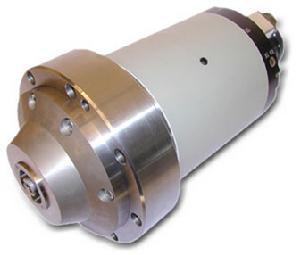CONTACT US
Zhejiang waxing electromechanical co.LTD.,Factory located in Shandong,Headquarters located in Zhejiang,China.

Hydrostatic bearing failure 1: pure liquid lubrication can not be established
Fault phenomenon: after automatic oil pump, if pure liquid lubrication has been established, it should be able to turn easily by hand;If the rotation is not moving or more difficult to rotate than without oil supply, it indicates that pure liquid lubrication has not been established.
Cause of failure: the pressure of an oil chamber of the bearing cannot be established, or the assembly quality of the bearing is too poor, such as:
(1) there is oil leakage in an oil chamber, so that the shaft is squeezed on one side of the bearing;
(2) There is no lubricating oil in an oil chamber of the bearing, and the oil inlet holes are misplaced during processing and assembly, or the throttle is blocked;
(3) the liquid resistance of each throttle is too large, resulting in no bearing capacity of an oil chamber;
(4) the stiffness of the elastic element of the feedback throttle is too low, causing the oil outlet hole to be blocked at one end;
(5) the coaxiality of the centripetal bearing is too large, or the verticality of the thrust bearing is too small, so that the lifting clearance of the spindle is too small.
Elimination method:
(1) Check whether the pressure of each oil chamber has been established.For oil leakage or oil cavity without pressure, find out the specific reasons and take corresponding measures to overcome them.
(2) Adjust the throttling ratio of each oil chamber to make it within a reasonable range;
(3) Reasonable design of throttle;
(4) keep the lubricating oil clean;
(5) To ensure the manufacturing accuracy and assembly quality of parts.
Hydrostatic bearing failure two, the pressure is not stable
Fault phenomena:
(1) When the main shaft does not rotate, after starting the oil pump, the pressure of each oil chamber will gradually decrease or the pressure of some oil chambers will decrease;
(2) After the spindle rotates, the pressure of each oil chamber changes periodically (if the change is greater than 0.05-0.1MPa, the reason must be checked);
(3) When the spindle does not rotate, each oil chamber is jitter due to pressure (more than 0.05~0.1MPa should be checked);
(4) When the spindle speed is high, the oil chamber pressure fluctuates irregularly.
Cause of failure:
(1) The throttle ratio β value is out of tolerance;
(2) Oil supply pressure P.Too low;
(3) the bearing clearance is too large;
(4) The throttle design is unreasonable.
Elimination method:
(1) replace the oil, clean the oil filter and throttle;
(2) Check whether there is large centrifugal force in the shaft and the parts on the shaft. If so, check whether there is interference force in the unloading belt by moving balance elimination, reduce the coaxiality error between the small unloading belt wheel and the spindle;
(3) Check oil pump and pressure valve;
(4) Improve the type of oil cavity.
Three, the oil film stiffness is insufficient
Fault phenomenon: the oil film stiffness of the spindle bearing does not meet the design requirements.
Cause of failure:
(1) The oil is not clean and the filtration clarity is not enough;
(2) impurities stored in bearings and tubing are not removed;
(3) the throttle is blocked;
(4) the shaft journal stiffness is insufficient, resulting in metal contact.
(5) Safety protection device failure.
Elimination method: according to the adjustment of oil film stiffness.
Hydrostatic bearing four, spindle drawing or holding shaft
Fault phenomenon: when the shaft rotates for a period of time, the spindle may be found to have the phenomenon of pulling or holding the shaft in operation.
Cause of failure:
(1) The oil is not clean and the filtration clarity is not enough;
(2) impurities stored in bearings and tubing are not removed;
(3) the throttle is blocked;
(4) The stiffness of shaft journal is insufficient, resulting in metal contact;
(5) Safety protection device failure.
Elimination method:
(1) Overhaul the oil filter;
(2) cleaning parts;
(3) Calculation of journal stiffness;
(4) maintenance of safety protection devices.
Hydrostatic bearing failure five: insufficient pressure rise in oil chamber
Fault phenomenon: although the throttle oil is smooth, the pressure in the oil chamber is not enough to rise.
Cause of failure:
(1) The bearing fit clearance is too large;
(2) oil leakage phenomenon;
(3) The oil pump is unqualified;
(4) the viscosity of lubricating oil is too low.
Elimination method:
(1) Measure the fit clearance. If it is too large, it needs to rematch the spindle;
(2) Eliminate oil leakage;
(3) Replace the oil pump;
(4) choose the right lubricating oil.
Hydrostatic bearing fault six: bearing temperature rise is too high
Fault phenomenon: when the spindle is running for about 2h, the oil pool or the outer wall of the spindle body temperature is out of tolerance.
Cause of failure:
(1) the bearing clearance is too small;
(2) the pressure of the shaft pump is too high;
(3) the viscosity of lubricating oil is too high;
(4) The friction area of oil chamber is too large.
Elimination method:
(1) Increase bearing clearance;
(2) Reduce the pressure of the oil pump under the condition of allowable bearing capacity and stiffness;
(3) reduce the viscosity of lubricating oil;
(4) Reduce the width of oil sealing surface, but make the width of oil sealing surface A and B greater than 40 times of the gap and ensure RE>2000.
Copyright © 2025 Zhejiang waxing electromechanical co.LTD. | All Rights Reserved Design
Hello, please leave your name email or WhatsApp here before chat online so that we won't miss your message and contact you smoothly.